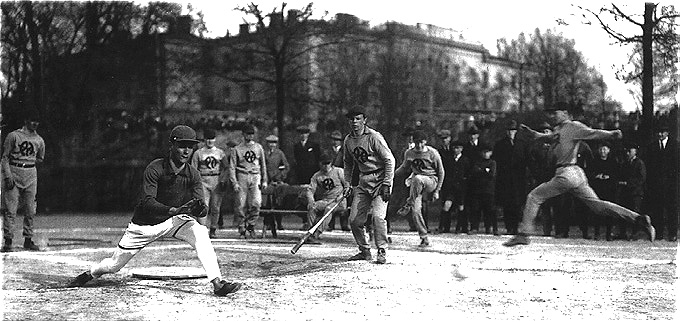Unified Nation
In Fair Wind (1920s)
Pesäpallo spread with the help of the civil guard. They adopted the new sport and spread it all over Finland through their efficient organization. The civil guard pesäpallo series was much larger than the pesäpallo championship series.

In the 1920s, the players’ shirts were uniform, but the style of pants varied.
Most played in “underpants” with sport shorts on top.
Schools and sports clubs also supported pesäpallo. In the time of longball, the clubs were organized by the Football Association of Finland. In 1925, the clubs resigned, and joined the Finnish Athletics Association (SVUL) as the pesäpallo division. In 1932, the SVUL divisions separated into independent associations. The Suomen Pesäpalloliitto (“Finnish Pesäpallo Association”) was established.

Hard play in the 1920s. Erkki Merinen of Pallo-Toverit has batted, and a runner strides towards home base.
Pitcher-catcher for Lahti, Olli Veijola waits for the ball bare-handed, as gloves were forbidden.
In the competitive circuit, Helsinki’s Pallonlyöjät ruled the 1920s. Founded in 1919, it was the first club centered on batting. The club took five national championships in the 1920s. The game was strong in the country, but the top teams came from the cities.
Ball in the Mitt (1930s
In the 1930s, pesäpallo attained a permanent position in Finnish sports. At the end of the decade, the game was the most popular ballgame in terms of the number of teams and players.
People in athletics and football periodically rose in fierce opposition to pesäpallo: a national sport fitted poorly into the world of international sports. Tahko Pihkala’s idea of a sports culture based on national ideas was not yet universally accepted.

Women’s pesäpallo fashion at the Helsinki Ballpark at the turn of 1930s. The uniform was a light and full dress.
The women’s pesäpallo series started at the end of the 1920s. The first Finnish championships were held in 1931.
The game was played mostly in the countryside. However, cities and industrial centres ruled the series. Almost all the top teams were from Southern Finland. The team of the decade was Lahti’s Maila-Veikot with four national championships. Regarding the number of teams in the series, the leading province was Southern Ostrobothnia. The civil guard series were active all over the country.

The East vs. West match has been played since 1932. Olli Veijola of the East and Pasi Harvela of the West drawing choice.
The East played in the red and black of Karelia, the West in blue and white.
In the 1930s, the ball “fitted like a glove” for pesäpallo players. The use of a mitt was allowed in 1931. Before that, the ball had been caught bare-handed or by wearing only a thin glove as protection against the impact.
Battle Fields (1940s)
The war disrupted all sports, including pesäpallo. The championship series was cut short in 1940, the summer after the Winter War. The series of summer 1941 was dropped. During the war summers of 1942 and 1943, an unofficial “wartime series” was played. The series was dropped as the great battles of the summer of 1944 began. Women and young people played only local games. Men’s pesäpallo centered on games between military units on the battle front.
After the war, the number of teams and players increased rapidly. The series were organized again and series levels added. New series for young people were created. Serious work for junior players began in the late 1940s. The greatest organizational change was the co-operation of SVUL and the Finnish Workers’ Sports Federation (TUL).
Those succeeding in the reconstruction period were Hamina’s Palloilijat and Toijala’s Pallo-Veikot. The former advanced at the famous Vallikenttä, the latter at the legendary market place.

